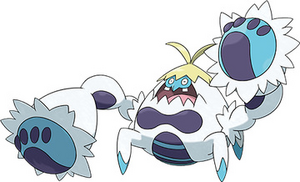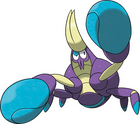| Crabominable | |||
|---|---|---|---|

| |||
| Naming | |||
| Others | Crabrawler (juvenile) | ||
| Original | ケケンカニ | ||
| Romanization | Kekenkani | ||
| Morphology | |||
| Body type | Crustacean | ||
| Average height | 60 cm (Crabrawler) 1.7 m (Crabominable) | ||
| Average weight | 7 kg (Crabrawler) 180 kg (Crabominable) | ||
| Intelligence | |||
| Sentience | Sentient | ||
| Sapience | Non-Sapient | ||
| Ecology | |||
| Place of origin | Alola region, Pokémon World | ||
| Habitat | Coastal (Crabrawler) Icy mountains (Crabominable) | ||
| Diet | Omnivorous | ||
| Locomotion | Quadrupedal | ||
| Behind the Scenes | |||
| Universe | Pokémon | ||
Crabominable is an ice/fighting-type Pokémon species from the Alolan archipelago. Its juvenile stage is known as Crabrawler and is a pure fighting-type. An individual Crabrawler can only evolve into Crabominable when it reaches Mt. Lanakila, the tallest mountain of the Alola region.
Biology
Crabrawler
Crabrawler is a medium-sized crustacean-like Pokémon. Its appearance somewhat resembles a coconut crab with only six limbs: two pairs of legs and a pair of powerful punching chelae. Its body is purple in coloration and the tips of its legs and chelae are usually blue, although in the rare shiny variant, they are red. When they lose a chela in battle, it can grow back. When they lose a battle, they foam from the mouth before fainting.

Like many fighting-type Pokémon, Crabrawlers are extremely competitive among their kin and will battle by exchanging punches with their chelae, much like in a boxing match. They also strive to reach for a literally higher position and will often climb trees and even cling to tall people just to be on the higher ground. It is this same instinct that sometimes causes this Pokémon to wander into the higher terrains and end up on Mt. Lanakila, where it can evolve.
Crabominable
Any Crabrawler that's brought to the snowy peaks of Mt. Lanakila and trains there until it levels up will evolve into its fully matured form, known as Crabominable. This much larger creature develops a thick white fur pelt to protect it from the weather. Its attacks are so violent that it can easily shatter ice walls to bits and even provoke avalanches. In times of desperation, it's capable of firing off its own chelae like rockets. Presumably, as in Crabrawler's case, they can regenerate after a while.
Cultural significance
Crabrawlers often lose their chelae in battle, and while they will regenerate later, the fallen chelae are often picked up and eaten by humans, as they're considered a delicacy.
